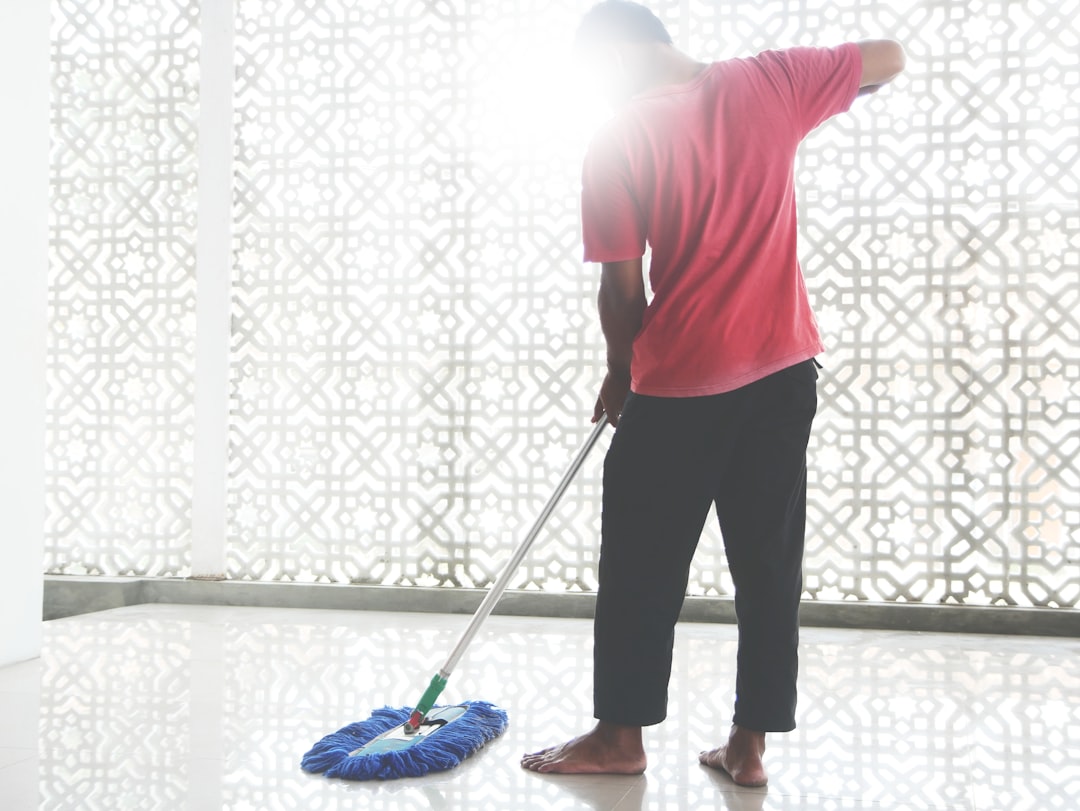Best way to clean and disinfect tile floors: 4-Step Sparkle
Why Proper Tile Floor Cleaning and Disinfection Matters
The best way to clean and disinfect tile floors combines the right techniques with material-specific care to maintain both beauty and hygiene. Here’s the complete approach:
The 4-Step Method:
- Prepare – Remove furniture and vacuum/sweep loose debris.
- Clean – Use pH-neutral cleaners with microfiber mops.
- Grout Care – Scrub grout lines with a baking soda paste or oxygen whitener.
- Disinfect – Rinse thoroughly and apply EPA-approved disinfectants with proper contact time.
Tile floors are valued for durability, but they can lose their shine without regular, thorough cleaning. The challenge isn’t just dirt—it’s knowing which methods work for your specific tile type. Ceramic and porcelain tiles need different care than natural stone like marble or granite. Using the wrong cleaner can permanently etch expensive marble floors.
Steam cleaning is a powerful, chemical-free solution. Steam mops use high-temperature steam to loosen and lift dirt, grime, and bacteria from hard, sealed surfaces, making it an effective eco-friendly method.
Proper disinfection requires more than just cleaning. High-traffic areas like kitchens and bathrooms need regular sanitizing to eliminate harmful bacteria.
As Ramy Saber, founder of الأميرة سندريلا A&C, my experience in flooring systems has taught me that the best way to clean and disinfect tile floors starts with understanding your material and following proven methods.
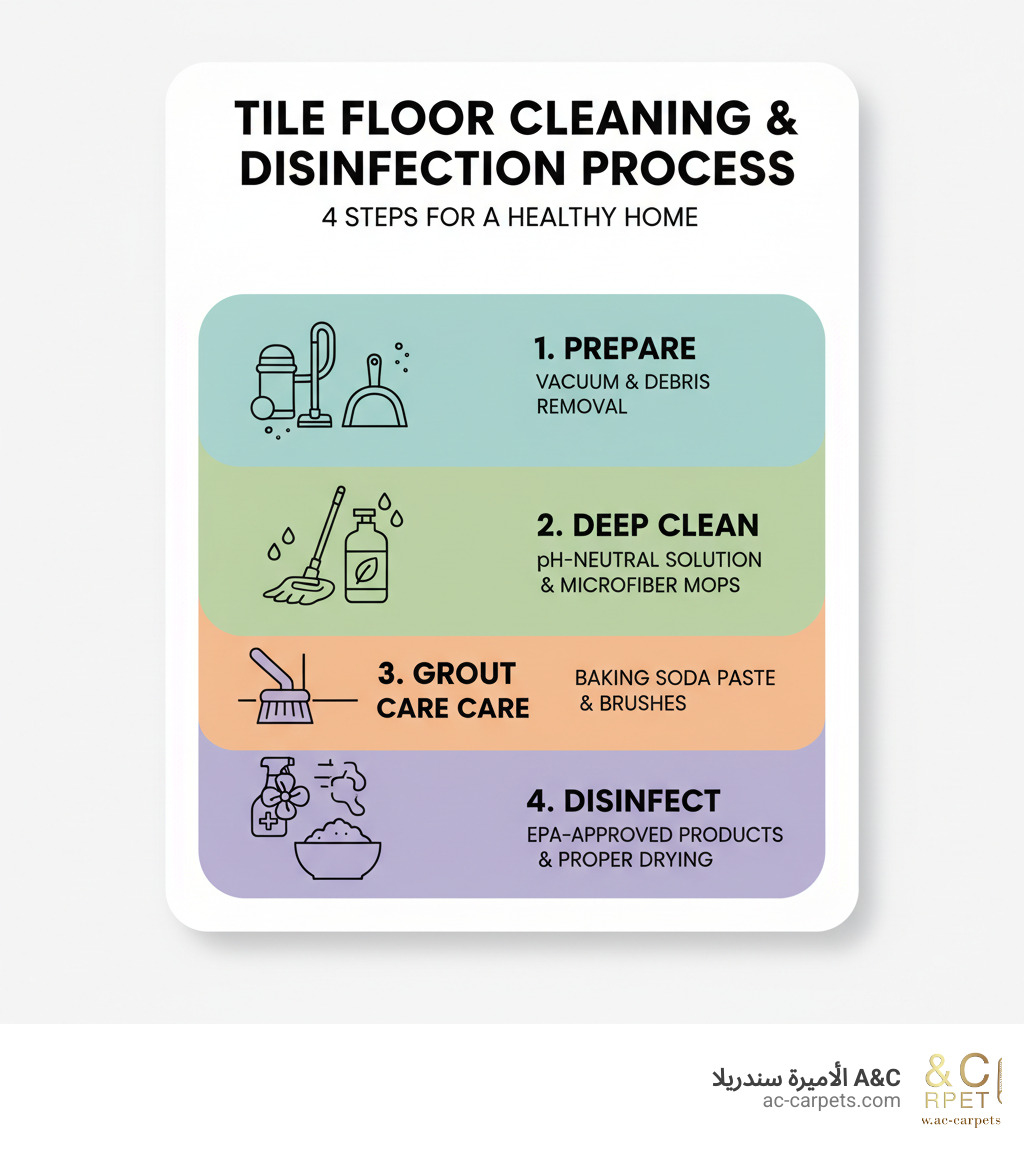
Before You Clean: A Guide to Tile and Grout Materials
Just as you wouldn’t use the wrong soap on a delicate fabric, different tile materials need special treatment. The best way to clean and disinfect tile floors starts with understanding what you’re working with to avoid costly mistakes, like using vinegar on marble and causing permanent etching.
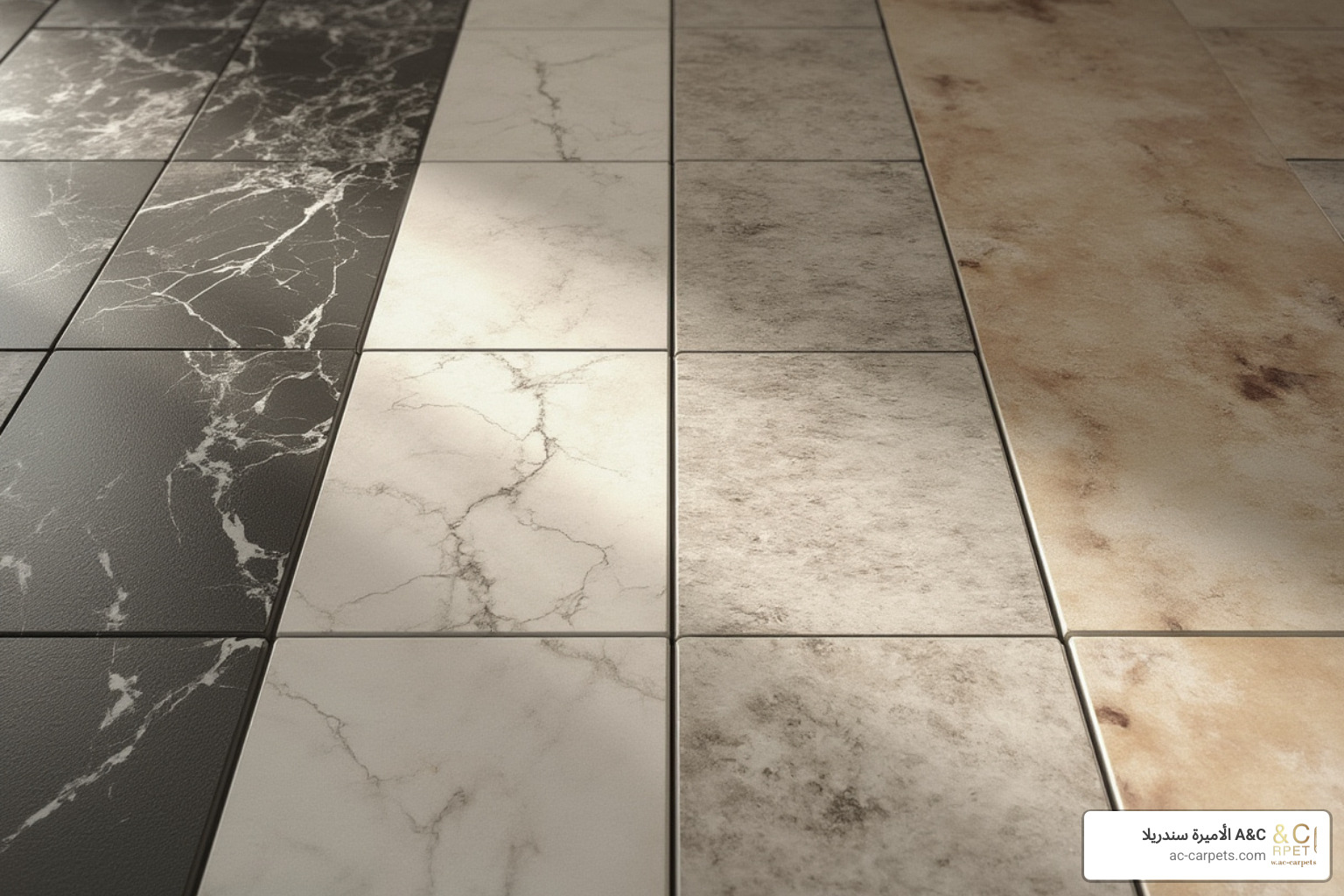
Identifying Your Floor Material
First, figure out your tile type:
Ceramic tile is a common, affordable, and durable option made from fired clay. Glazed ceramic has a protective coating, making it easy to clean, while unglazed ceramic has a matte look but stains more easily.
Porcelain tile is denser, harder, and less porous than ceramic. A key difference is that porcelain’s color runs all the way through the tile, and its surface feels smoother.
Natural stone tiles like marble, granite, and slate are cut from quarries, each with unique patterns. To test for natural stone, place a drop of water in an inconspicuous spot. If it darkens as the water absorbs, it’s likely natural stone. Marble is known for its veining but is easily damaged by acids, while granite is tougher but still requires gentle care.
Resilient tiles include vinyl, linoleum, and cork. These are comfortable, budget-friendly options. Vinyl is waterproof, linoleum is durable but sensitive to excess water, and cork is soft but needs sealing to prevent stains.
Your grout is also important. Sanded grout is for wider gaps, unsanded grout is for narrow lines, and epoxy grout is a premium, stain-resistant choice.
Cleaners and Tools to Avoid for Certain Tiles
Avoid these common mistakes to prevent floor damage:
- Acidic cleaners (vinegar, lemon juice) are enemies of natural stone. Never use them on marble, granite, limestone, or travertine, as the acid will permanently etch the surface, leaving dull spots.
- Abrasive powders and steel wool will scratch glazed ceramic, porcelain, and natural stone, dulling the finish over time.
- Stiff-bristled brushes are great for durable grout but can damage delicate tiles. Match the brush to your tile’s toughness.
- Steam mops are excellent for sealed ceramic and porcelain but should never be used on resilient floors like vinyl, linoleum, or cork, as the heat can cause warping. Be cautious with old or unsealed grout, as frequent steaming might weaken it.
Understanding these guidelines is key to success. At الأميرة سندريلا A&C, we know proper care keeps floors beautiful for decades. Now that you know your tile type and what to avoid, you’re ready to clean.
The 4-Step Method: The Best Way to Clean and Disinfect Tile Floors
This comprehensive 4-step approach creates a hygienic environment and is the best way to clean and disinfect tile floors safely and effectively.
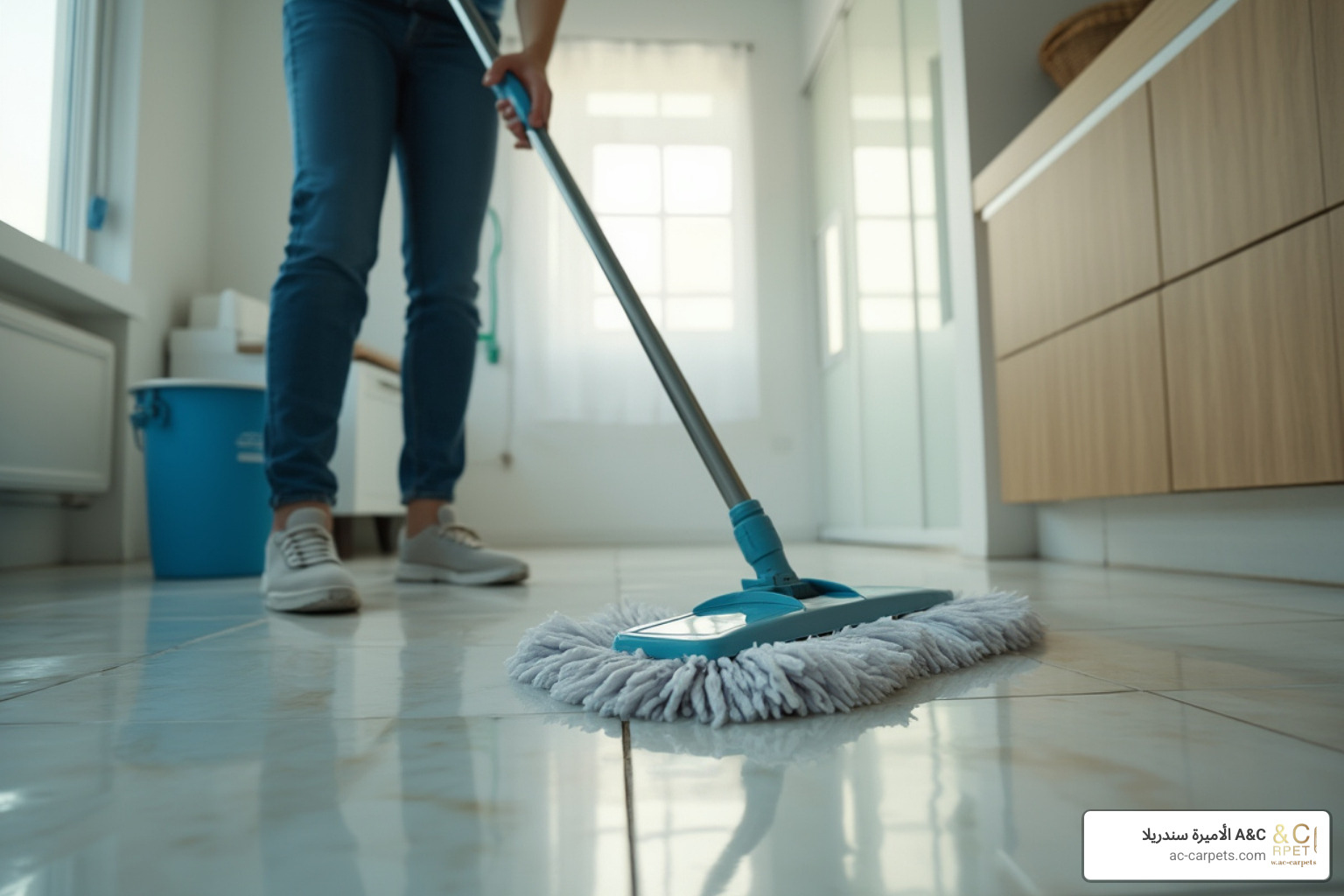
Step 1: Prepare the Surface by Removing Loose Debris
Preparing the surface makes the following steps more effective. Start by moving any furniture and rugs to get clear access to the entire floor.
Next, sweep or vacuum to remove all loose debris. A vacuum with a HEPA filter and soft-bristle attachment is better than sweeping, as it captures fine dust instead of just pushing it around. A HEPA-filtered stick vacuum is great for pet hair and fine particles.
Use a crevice tool for edges and corners where dust collects. This prevents grit from scratching your tiles during the wet cleaning phase.
Step 2: Deep Clean the Tile with the Right Solution
With the surface prepped, it’s time for a deep clean. The key is using the right cleaner and technique.
pH-neutral cleaners are best for most tiles, especially natural stone. For ceramic and porcelain, a mild detergent works well. A simple, effective option is warm water with a few drops of mild, pH-neutral dish soap or castile soap. You can also find great recipes for DIY Homemade Cleaners {Vinyl + Tile Cleaner}.
Microfiber mops are a worthwhile investment because they trap dirt and absorb moisture, unlike sponge mops that push dirty water around. For larger or dirtier floors, use the two-bucket method: one bucket for your cleaning solution and another for clean rinse water. This prevents you from spreading dirty water.
Work in manageable sections (about four feet square) to prevent the solution from drying on the tiles. Start in the farthest corner and work toward the exit.
Step 3: The best way to clean and disinfect tile floors includes tackling grout
Clean tiles can still look dull if the grout is discolored. Grout’s porous nature makes it a magnet for dirt, grime, and mildew.
Baking soda paste is a great solution. Mix baking soda with water to create a thick paste, apply it to grout lines, and let it sit overnight for stubborn stains. The next morning, a good scrub will lift away embedded dirt.
For tougher stains, oxygen whitener provides extra cleaning power without harsh bleach. Sprinkle it on the grout, spray with hot water to activate, and let it work before scrubbing.
The right tools are essential. Grout brushes have stiff, narrow bristles for tight spaces. For larger areas, a long-handled deck brush saves your back.
Steam cleaning with a nozzle attachment is a chemical-free and effective method. The high-temperature steam penetrates grout pores, loosening dirt and sanitizing simultaneously.
Step 4: Rinse Thoroughly and Disinfect for a Hygienic Finish
This final step is critical for a truly hygienic finish. Thorough rinsing is non-negotiable to prevent a sticky, hazy film that attracts more dirt. Use clean water and a fresh microfiber mop, changing the water frequently.
For natural stone, wring your mop thoroughly and dry the surface immediately with a clean cloth to prevent water spots.
Sticky floors after mopping are almost always caused by inadequate rinsing. Multiple rinses with clean water are better than one quick pass.
For disinfection, especially in kitchens and bathrooms, use EPA-approved disinfectants. Follow the label’s instructions for contact time, which is typically 5-10 minutes of the surface remaining wet.
Steam cleaning offers excellent chemical-free disinfection for sealed tiles. The high temperature (around 212°F) kills bacteria and viruses. Move the steam mop slowly to allow the heat to work.
Air drying is fine for most tiles, but drying glazed ceramic, porcelain, and natural stone with a clean microfiber cloth prevents water spots and streaks.
Following these steps ensures your floors are deeply cleaned and disinfected. For more tips, see our guide on Tile Cleaning for Durability and Care.
Maintaining Your Tile Floors for Lasting Shine and Hygiene
Consistent care is the key to long-lasting floors. The best way to clean and disinfect tile floors involves creating habits that keep them beautiful and healthy day after day, making weekly cleaning a breeze rather than a chore.
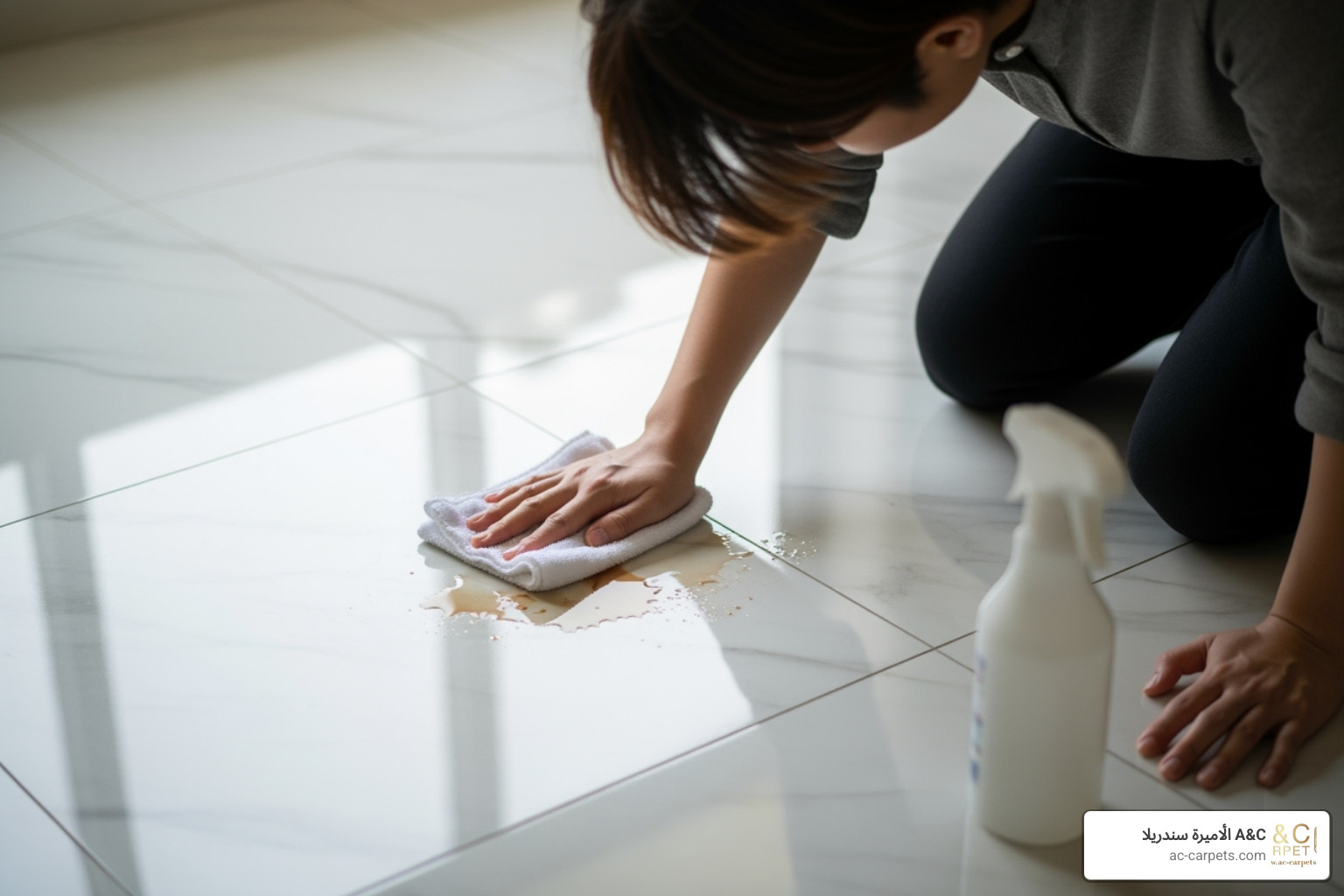
How Often Should You Clean Tile Floors and Grout?
Your cleaning schedule should match your lifestyle, but here are some general guidelines:
- Daily: Sweep or vacuum high-traffic areas to prevent dirt buildup, especially in homes with pets.
- Weekly: Mop most floors once a week. Kitchens and bathrooms may need it twice a week due to higher traffic and spills.
- Immediately: Spot clean spills with a damp cloth to prevent stains from setting.
- Periodically: Deep clean grout every few months if it looks dingy. A thorough steam clean every 6-12 months will keep it looking new.
Troubleshooting: Why Do My Tiles Still Look Dirty After Mopping?
If your floors look streaky or dull after mopping, one of these common issues is likely the cause:
- Soap residue: Using too much cleaner or not rinsing thoroughly leaves a hazy film that attracts dirt. To fix this, mop again with plain, clean water, changing it frequently.
- Hard water spots: If your tap water is hard, it can leave dull spots. Try using distilled water for the final rinse.
- Dirty mop water: Using cloudy water just moves dirt around. Change your water as soon as it looks dirty. The two-bucket method helps prevent this.
- Grout haze: New tile can have a haze from installation that requires a specialized cleaner. For this, or for deep stains and etching, you may need to call a professional.
For more troubleshooting tips, see our guide on Tile Cleaning and Maintenance.
The best way to clean and disinfect tile floors using steam
Steam cleaning offers powerful results without harsh chemicals. The high-temperature steam (around 212°F) provides several benefits:
- Chemical-free sanitizing: It kills 99.9% of bacteria and viruses, making it ideal for families with children, pets, or chemical sensitivities.
- Loosens stubborn grime: The heat and moisture penetrate pores and grout lines, softening dried-on dirt and grease for easy removal with less scrubbing.
Steam mops are great for overall floor cleaning, while handheld steamers with brush attachments are perfect for targeting grout lines and corners.
However, steam is not for every surface. Never use steam on resilient floors like vinyl, linoleum, or cork, as the heat can cause warping. Use caution with unsealed or damaged grout, as high-pressure steam could weaken it over time.
For more expert techniques, see this guide on How to Clean Every Type of Tile Floor, According to Cleaning Experts.
Frequently Asked Questions about Cleaning Tile Floors
Here are answers to common questions to help you master the best way to clean and disinfect tile floors and avoid frequent mistakes.
What is a safe, all-purpose DIY cleaner for most tile floors?
A simple, effective DIY cleaner for most ceramic and porcelain tiles uses basic ingredients. My go-to recipe is 1 gallon of warm water with 1 teaspoon of liquid castile soap. This pH-neutral solution is gentle and won’t leave a dulling residue. For a fresh scent, add 5-10 drops of essential oils like lemon or lavender.
Important: Avoid using castile soap on unsealed natural stone, as it can leave a film. For marble, granite, or travertine, use plain water or a dedicated stone cleaner.
Can I use vinegar to clean all my tile floors?
No. The common belief that vinegar is safe for all tile is a dangerous myth. While its acidic nature is great for cutting grease on ceramic and porcelain tiles (use 1/2 cup white vinegar per gallon of warm water), it should never be used on natural stone like marble, travertine, or limestone. The acid will react with the stone and cause permanent etching, which appears as dull spots.
Frequent use of concentrated vinegar can also weaken unsealed, cement-based grout over time. Always know your floor material before using vinegar.
How do I get my grout white again without harsh chemicals?
You can restore white grout using gentle, non-toxic methods:
- Baking soda paste: Mix baking soda with water to form a thick paste. Apply it to grout lines and let it sit for several hours or overnight before scrubbing with a stiff nylon brush. Its alkaline and mildly abrasive properties will lift embedded dirt.
- Oxygen whitener: For tougher stains, sprinkle oxygen whitener on wet grout lines or mix it into a paste. Let it sit for 15-30 minutes before scrubbing. The oxygen bubbles help break down stains without the fumes of chlorine bleach.
- Steam cleaning: A handheld steam cleaner with a brush attachment is a highly effective, chemical-free method that loosens dirt while sanitizing.
The key to keeping grout white is regular maintenance. Weekly scrubbing with a mild cleaner prevents heavy buildup.
Conclusion: Your Partner in Beautiful, Long-Lasting Floors
You now have a manageable routine for the best way to clean and disinfect tile floors, keeping them beautiful, healthy, and long-lasting. You know how to choose the right cleaner for your tile type and how to avoid common problems like sticky residue.
Our 4-step method—Prepare, Clean, Grout Care, and Disinfect—is your blueprint for protecting your investment. By using pH-neutral cleaners, tackling grout correctly, and leveraging the power of steam, you can achieve a professional, chemical-free clean.
Regular maintenance is key. Daily sweeping, weekly mopping, and immediate spot-cleaning will keep your floors stunning for decades.
At الأميرة سندريلا A&C, we believe beautiful floors are the foundation of a welcoming space. We specialize in innovative and modern flooring solutions designed for durability and elegance in homes, offices, and hotels. Our commitment is to provide quality products and the knowledge to maintain them.
Now you have the know-how to keep your floors pristine. Ready to explore flooring options that make maintenance even easier? Explore our neat and practical flooring solutions and see how the right choice can transform your space.
